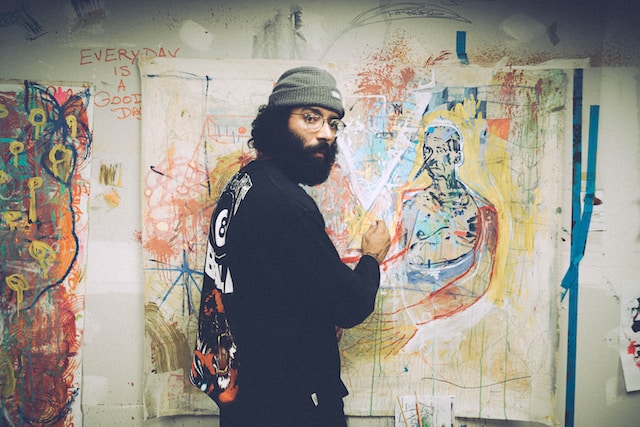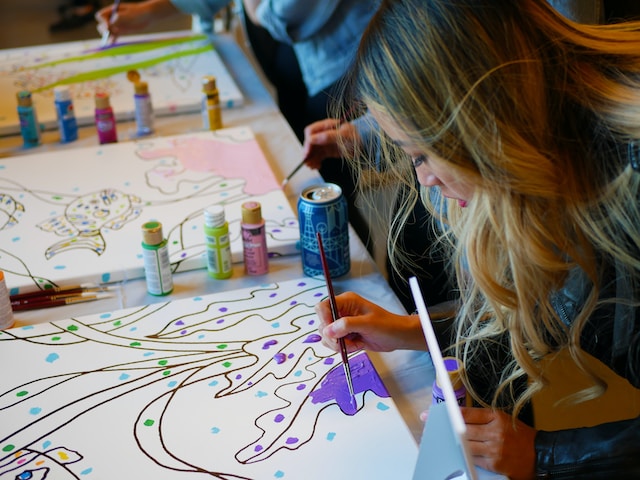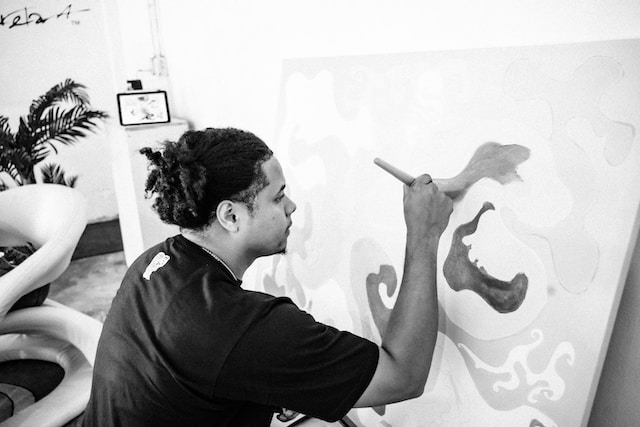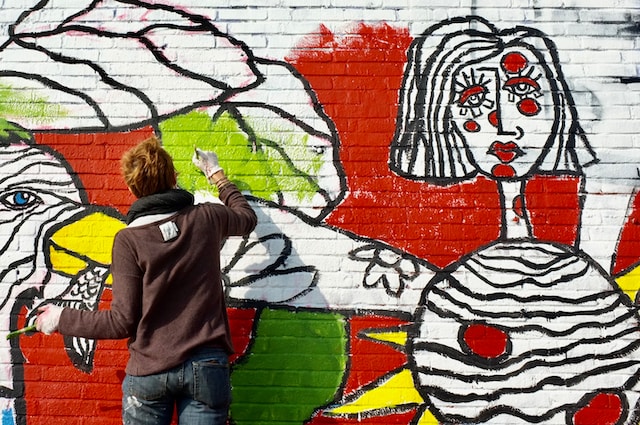
Expressive Art Therapy offers a unique and powerful path to healing and self-discovery, and you don’t need to consider yourself a traditional “artist” to reap its benefits. This form of therapy invites individuals from all walks of life to tap into their innate creativity as a means of exploring and understanding their emotions, experiences, and inner world. Whether you’ve never picked up a paintbrush or you’re a seasoned artist, Expressive Art Therapy can be a transformative journey for anyone seeking support and growth.
Through various creative mediums this therapy provides a safe and non-judgmental space to express yourself, process challenging emotions, and find new perspectives on life’s complexities. It’s a holistic approach that recognizes the power of the creative process in fostering self-discovery, personal insight, and emotional well-being. So, if you’re open to exploring your inner world and embarking on a therapeutic journey that transcends artistic skill, Expressive Art Therapy might be the perfect avenue for you to embark on a profound voyage of self-exploration and healing.
Find a therapist.

What is Expressive Art Therapy?
Expressive Art Therapy is a form of psychotherapy that uses various forms of creative expression to promote healing and emotional well-being. It encourages individuals to explore and communicate their thoughts, feelings, and experiences through art, such as painting, drawing, sculpture, music, dance, drama, and writing. The process of creating and engaging with art is believed to foster self-discovery, self-expression, and personal growth.
What To Expect in Expressive Art Therapy Sessions
In Expressive Art Therapy, the emphasis is not on the final product but on the creative process itself. Therapists trained in this approach provide a safe and supportive environment where clients can freely express themselves through art. The therapist may guide the process, interpret the client’s artwork, and facilitate discussions to help clients gain insights into their emotions, conflicts, and life experiences.
While specific activities may vary depending on the therapist’s approach and your individual goals, here are some common elements and activities you might encounter in an expressive arts therapy session:
Creative Exploration
You’ll be encouraged to engage in creative activities such as painting, drawing, sculpting, music-making, dancing, writing, or even dramatic role-play. These activities serve as tools for self-expression and exploration.
Free Expression
There’s no pressure to create a masterpiece or adhere to artistic conventions. Expressive arts therapy is about the process, not the product. You’re free to explore and express yourself in a way that feels comfortable and authentic.
Reflective Dialogue
After engaging in a creative activity, you’ll have the opportunity to discuss your experience with the therapist. This dialogue can help you gain insights into the emotions, thoughts, and memories that may have surfaced during the creative process.
Metaphor and Symbolism
Creative expression often taps into the subconscious mind, allowing you to communicate complex feelings and experiences symbolically. The therapist will help you explore the meaning behind your creations and how they relate to your life.
Mindfulness and Presence
Many expressive arts therapy sessions incorporate mindfulness techniques to help you stay present and fully engage in the creative process. Mindfulness can enhance self-awareness and emotional regulation.
Personal Growth
Over time, you may notice personal growth, increased self-awareness, and a deeper understanding of your inner world. Expressive arts therapy can help you develop coping skills, gain insights, and promote emotional healing.
Flexibility
Expressive arts therapy is highly adaptable to your unique needs and preferences. Your therapist will tailor activities and interventions to address your specific therapeutic goals.
Integration
The insights gained through creative expression are often integrated into your everyday life. You may discover new ways to approach challenges, make decisions, or cope with stress.
Who is Expressive Art Therapy For?
Expressive Art Therapy can be beneficial for individuals of all ages and backgrounds and is used to address a wide range of emotional and psychological issues, including trauma, anxiety, depression, grief, stress, relationship difficulties, and personal growth. It can be practiced individually or in group settings, depending on the therapeutic goals and the preferences of the client.
Do You Have To Be an Artist?
No, you do not have to be an artist or consider yourself creative to benefit from expressive art therapy. Expressive art therapy is designed to be inclusive and accessible to individuals of all artistic backgrounds and skill levels. In fact, it’s often especially beneficial for those who may not have prior experience in the arts.
Expressive art therapy can be particularly helpful for individuals who may find it challenging to express themselves verbally or who prefer alternative forms of communication. It is a versatile and adaptable approach that can be customized to meet the unique needs and goals of each individual, regardless of their prior artistic experience.
Is Expressive Art Therapy For Kids?
Expressive art therapy is not limited to children; it is an approach that can be used with individuals of all ages, including adults. While expressive art therapy is commonly used with children and adolescents, it is also highly effective for adults and older adults.
For Children and Adolescents
Expressive art therapy can be particularly well-suited for children and adolescents because it allows them to communicate their thoughts, feelings, and experiences in a non-verbal and creative way. Children may find it easier to express themselves through art, music, play, and other creative activities than through traditional talk therapy. It can help them process emotions, cope with stress, and address a wide range of emotional and behavioral challenges.
For Adults
Expressive art therapy is equally valuable for adults. It offers a unique opportunity for adults to explore their inner world, gain insight, and address emotional or psychological issues. Adults may use various creative modalities such as visual arts, music, movement, writing, and drama to express themselves, enhance self-awareness, and promote personal growth. It can be particularly effective for adults who have difficulty expressing their emotions verbally or who are looking for alternative therapeutic approaches.
Benefits of Expressive Art Therapy
It’s important to note that the specific benefits experienced in expressive art therapy may vary from person to person, and the effectiveness of the approach depends on individual goals and preferences. Some common benefits include:
- Facilitates Self-Expression
- Promotes Emotional Release
- Enhances Self-Awareness
- Supports Stress Reduction
- Encourages Communication
- Fosters Personal Growth
- Boosts Self-Esteem
- Provides Catharsis
- Develops Coping Skills
- Supports Trauma Healing
- Enhances Communication with Therapist
- Encourages Play and Exploration
- Offers a Non-Judgmental Space
- Increases Resilience
- Supports Holistic Well-Being
How Expressive Arts Therapy Helps With Particular Challenges
Expressive arts therapy can be particularly effective in addressing a wide range of emotional and psychological issues, including depression, anxiety, divorce, and life transitions. Here’s how it helps with these common challenges:
Depression
Expressive arts therapy provides a creative outlet for individuals experiencing depression to express their feelings and gain insight into their emotions. Engaging in art, music, dance, or other creative activities can improve mood, boost self-esteem, and promote a sense of accomplishment.
Anxiety
Creative expression in therapy can reduce anxiety by encouraging individuals to focus on the present moment and divert their attention from anxious thoughts. It allows for the release of tension and promotes relaxation, helping individuals manage anxiety symptoms.
Divorce
Going through a divorce can be emotionally challenging. Expressive arts therapy can help individuals process their emotions, cope with grief, and navigate the complex feelings associated with divorce. It fosters self-reflection and provides a safe space to explore these emotions.
Life Transitions
Life transitions, such as retirement, relocation, or career changes, can be stressful. Expressive arts therapy supports individuals in adapting to these transitions by promoting self-awareness and offering a means of exploring their concerns and goals.
Trauma
For individuals who have experienced trauma, expressive arts therapy can provide a non-verbal way to process traumatic memories and emotions. It allows trauma survivors to regain a sense of control and release pent-up feelings.
Self-Exploration
Expressive arts therapy is especially beneficial for those seeking self-exploration and personal growth. It encourages individuals to delve into their inner world, gain a deeper understanding of themselves, and develop greater self-acceptance.
Addiction Recovery
Expressive arts therapy can support individuals in addiction recovery by providing alternative coping mechanisms, addressing underlying emotional issues, and promoting self-expression in a safe environment.
Grief and Loss
Expressive arts therapy is particularly useful for individuals dealing with grief and loss. It allows them to express their emotions, memories, and thoughts about the deceased or the loss they’re experiencing.
Parenting Challenges
Parents can benefit from expressive arts therapy as it helps them explore their feelings, challenges, and aspirations related to parenting. It can also provide tools for improving parent-child relationships.
Eating Disorders
It can be a valuable complement to traditional therapy in the treatment of eating disorders. Expressive arts therapy allows individuals to explore their relationship with food, body, and emotions.
Creativity Enhancement
It’s also valuable for individuals looking to boost their creativity and innovation in various aspects of life, including problem-solving, decision-making, and personal or professional projects.
Expressive Arts Therapy vs. Dance/Movement Therapy
Expressive arts therapy is a broader therapeutic approach that incorporates various forms of creative expression, including visual arts, music, dance, movement, drama, and writing. It allows individuals to use multiple art forms to explore their emotions, thoughts, and experiences. The emphasis in expressive arts therapy is on the creative process itself, and individuals may engage in a combination of art modalities during a session.
On the other hand, dance/movement therapy is a specific form of therapy that focuses primarily on the use of dance and movement as a means of self-expression and healing. It involves the physical and kinesthetic aspects of movement to help individuals explore and process their emotions, improve body awareness, and address psychological issues. Dance/movement therapists are trained to use movement as a therapeutic tool to support clients in achieving their therapeutic goals.
Expressive Arts Therapy and Other Types of Therapy
Expressive arts therapy can be effectively combined with a variety of common therapeutic approaches to enhance the therapeutic process and provide more holistic support to clients. Here are examples of how expressive arts therapy can be used in combination with other types of therapy:
Cognitive-Behavioral Therapy (CBT)
n CBT, clients may identify negative thought patterns and behaviors. Expressive arts therapy can complement this by allowing clients to visually represent these thoughts and behaviors through artwork. This process helps clients gain insight and challenge cognitive distortions more creatively.
Psychodynamic Therapy
Psychodynamic therapy explores unconscious processes and unresolved conflicts. Expressive arts therapy can facilitate the expression of these unconscious emotions and conflicts through artistic means, enabling clients to process them symbolically.
Mindfulness-Based Approaches
Mindfulness practices are often combined with expressive arts therapy to enhance self-awareness and present-moment focus. Clients may engage in mindfulness meditation before or after engaging in creative expression to deepen their connection to their artwork and emotions.
Narrative Therapy
In narrative therapy, clients examine and reframe their life stories. Expressive arts therapy can help clients externalize their stories by creating visual representations or narratives through art, which can then be reevaluated and restructured.
Somatic Therapy
Somatic therapy involves exploring the connection between the body and emotions. Expressive arts therapy can be used to encourage clients to depict bodily sensations, tension, or movement patterns through art or movement, facilitating a deeper understanding of somatic experiences.
Trauma-Informed Therapy
Trauma-informed therapy often focuses on processing traumatic memories and their impact. Expressive arts therapy can offer a safe and non-verbal way for clients to explore and communicate their trauma experiences, allowing for gradual healing and emotional release.
Humanistic Therapy (e.g., Person-Centered Therapy)
Humanistic therapy emphasizes self-actualization and personal growth. Expressive arts therapy aligns well with this approach, as it empowers clients to explore their inner selves, self-expression, and creativity as they work toward personal growth and self-discovery.
Family Therapy
In family therapy, expressive arts activities can be used to facilitate family members’ communication, expression of emotions, and exploration of family dynamics. Family members may create collaborative art projects to foster connection and understanding.
Gestalt Therapy
Gestalt therapy focuses on present-moment awareness and integration. Expressive arts therapy can help clients explore and process their present feelings and experiences through artistic expression, aiding in self-awareness and integration.
Attachment-Based Therapy
Expressive arts therapy can assist clients in exploring their attachment patterns and experiences. Clients may create art that represents their attachment relationships, helping them gain insight into their attachment history and needs.
Next Steps:
Therapists who practice Expressive Art Therapy typically receive specialized training in this approach. Training programs for Expressive Art Therapy vary, but they often involve a combination of academic coursework and supervised practical experience.
Are you ready to find a therapist who specializes in Expressive Art Therapy ? Search our therapist directory today to find the one who is right for you. Or call us for more information.

